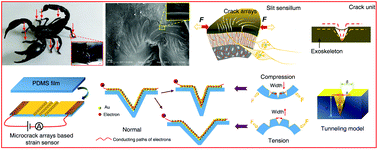High-performance flexible strain sensor with bio-inspired crack arrays†
Abstract
Biomimetic sensor technology is always superior to existing human technologies. The scorpion, especially the forest scorpion, has a unique ability to detect subtle vibrations, which is attributed to the microcrack-shaped slit sensillum on its legs. Here, the biological sensing mechanism of the typical scorpion (Heterometrus petersii) was intensively studied in order to newly design and significantly improve the flexible strain sensors. Benefiting from the easy-crack property of polystyrene (PS) and using the solvent-induced swelling as well as double template transferring method, regular and controllable microcrack arrays were successfully fabricated on top of polydimethylsiloxane (PDMS). Using this method, any physical damage to PDMS could be effectively avoided. More fortunately, this bio-inspired crack arrays fabricated in this work also had a radial-like pattern similar to the slit sensillum of the scorpion, which was another unexpected imitation. The gauge factor (GF) of the sensor was conservatively evaluated at 5888.89 upon 2% strain and the response time was 297 ms. Afterward, it was demonstrated that the bio-inspired regular microcrack arrays could also significantly enhance the performance of traditional strain sensors, especially in terms of the sensitivity and response time. The practical applications, such as the detection of human motions and surface folding, were also tested in this work, with the results showing significant potential applications in numerous fields. This work changes the traditional waste cracks on some damaged products into valuable things for ultrasensitive mechanical sensors. Moreover, with this manufacturing technique, we could easily realize the simple, low cost and large-scale fabrication of advanced bioinpired sensors.



 Please wait while we load your content...
Please wait while we load your content...